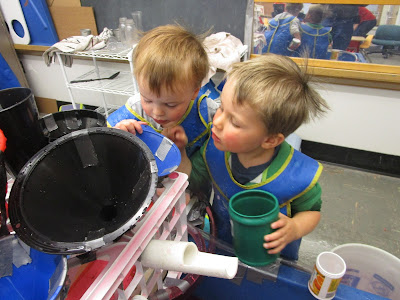The setup for the Funnels and Clear Plastic Tubing is slightly different this year. There are a total of six funnels taped to the crate.
The funnels are numbered one through six above. There are corresponding numbers to show where the water goes when poured into each tube. Two of the tubes are longer this year, so when children look inside the crate to track any given tube, it looks like tube spaghetti.
Watch how one child tries to figure out the path of the water in one of the longer tubes. Notice especially how she looks inside the crate and bobs her head up and down as she follows the tube from the funnel to the tube through the crate.
There is a lot going on in the video so it is not always easy to figure out where the water goes when a child pours it into a funnel. A case in point is near the end of the video when a child pours water in another funnel that leads to a sprinkler but, because the girl makes such a strong point that the water is emptying into the big white bucket, the boy looks for his water to empty into that bucket instead of seeing that his water actually comes out the sprinkler.
This year I have a video that captures how a child can focus on how the water empties from a funnel. Watch the concentration of the child as he watches the funnel completely empty of water. It is all the more impressive because as he focuses, another child pours water at close quarters into the funnel right next to him.
Funnel watching from Thomas Bedard on Vimeo.
Is it the whirlpool that fascinates him? He climbs up on a stool to pour and watch the water. Can he focus so well because the funnel is at his eye-level? In any case, it seems to be contagious.
One day I left the tube that emptied into the white bucket hanging back into the table. One child's experimentation with water hydraulics caught my eye. The child holds the end of the tube up as he pours water into the funnel it is attached to. He does not even watch himself pour, but focuses on the end of the tube. Because he is pouring in a deliberate and measured way, he can watch the level of the water rise in the tube until it spills out. He keeps watching it as his cup empties and the water level drops. When no more water comes out, he still focuses on the end of the tube because as he lets go of the tube, water again spills out.
Filling the tube from Thomas Bedard on Vimeo.
One child takes this experimentation with the tube hydraulics one step further. He places an empty juice can over the end of the tube. When he pours water into the funnel, the force of the water coming out of the tube launches the can into the table.
Tube hydraulics from Thomas Bedard on Vimeo.
You think he is pleased with his experiment? The adorable smile tells us he thinks he has discovered something pretty cool.
This apparatus lends itself well to eliciting what must be considered real scientific inquiry by the children. Even with that understanding, one of my favorite clips at the apparatus this year has little to do with science. Rather, it is a video clip of a child taking a familiar tune and adding his own words that relate to exactly what he is doing. As the child scoops water in his spoon he sings: "Do you know the scooping man, the scooping man who lives in California?" He sings it to the tune of Do you know the muffin man? When he picks up a bucket, the verse changes to: "Do you know the bucket man who lives in California?
Do you know the scooping man? from Thomas Bedard on Vimeo.
Is this creativity? This is a creative mashup of a familiar tune using his own words. What I was struck by, though, was that this was the first time I have heard this child burst out in spontaneous song. There is something really beautiful when you see a child so comfortable with who he is in that given moment that he erupts into song, a song of his own making.




No comments:
Post a Comment